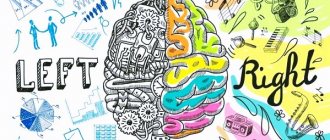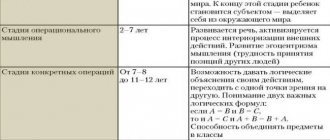Thinking is determined by a person’s needs, his interests, motives, tasks, goals, that is, a person’s thinking is purposeful in nature, associated with the needs and motivation of a particular individual.
A person’s individual thinking is directly related to his mind, but the concept of mind is broader: it includes features of both thinking and other cognitive processes. Thinking is the processing of information, a set of interconnected sensations, thoughts, and images. As a result, it gives us an idea of how everything in nature relates to each other. Thinking is a tool of the mind, one of its prerequisites. The mind is the repository of knowledge, intelligence, intuition, personality traits (its beliefs, positions, programs), it determines a person’s ability to think and solve emerging problems.
A person’s upbringing, his training, the chosen type of occupation, preferences, and the uniqueness of life constitute the features of the individual characteristics of a person’s thinking. Age, the type of higher nervous activity, and the ratio of the first and second signaling systems are also important. You can read more about types of thinking in our blog:
Thinking concept
In perception and sensation, a person perceives the world around him as the result of direct, sensory reflection. However, internal laws, the essence of things, cannot be directly reflected in our consciousness.
No pattern can be perceived directly by the senses. Cognition is based on the recognition of connections and relationships between things. Thought is an indirect and generalized reflection of essential, regular relations of reality.
This is a generalized orientation in certain situations of reality. In the structure of the human psyche, thinking as a phenomenon, which is a common feature of a person, refers to mental cognitive processes, which are the primary reflection and awareness by a person of the consequences of the surrounding reality. Traditional definitions in psychological science, as a rule, establish two of its main features: generalization and mediation, i.e. thinking is a process of generalized and indirect reflection of reality in its basic contexts and relationships. Thinking is a process of cognitive activity in which the subject works with various types of generalizations, including images, concepts and categories.
The essence of thinking is to perform some cognitive operations with images in the internal picture of the world. These operations make it possible to build and reconstruct a changing model of the world.
World of Science
Subject to general laws, the thinking of a particular person is also characterized by significant individual characteristics, which manifest themselves in the depth of thoughts, their independence, criticality, consistency, flexibility and speed. Sometimes these characteristics are called qualities of the mind.
The depth of thinking is manifested in a person’s ability to penetrate into the essence of phenomena, to be cognized, to highlight their essential characteristics, to reveal the causes, to identify their connections with other phenomena, to foresee their further development. The opposite feature is superficiality of thinking, which consists in the fact that a person identifies storied, unimportant signs of phenomena from which reliable conclusions cannot be drawn. Independence of thinking is characterized by a person’s ability to pose new problems, find unheard of, often original, approaches to solving them, and take initiative in creative search. Critical thinking lies in the ability of an individual to strictly evaluate his thoughts and outside influences, to identify strong and weak aspects in them, not to accept every guess as truth, but to question and check it. Uncritical thinking is characterized by the fact that a person easily perceives other people's thoughts without proper verification and evaluation. Consistency of thinking presupposes a person’s ability to adhere to logical rules and not contradict himself in reasoning, to prove and justify his assessments and conclusions. Inconsistency manifests itself in the chaotic nature of a person’s reasoning and does not allow him to successfully complete assigned tasks. Flexibility of thinking is characterized by a person’s ability to easily move from one method of solving a problem to another if the first method turned out to be inappropriate, to be free from patterns, and to quickly respond to changing circumstances. The opposite feature is inertia of thinking, which manifests itself in slowness of thinking and a tendency to take standard actions. The speed of thinking is determined by the time during which a person copes with certain tasks. The features considered are the most important. However, their list does not exhaust the diversity of mental activity of various individuals. Moreover, man does not receive them from nature. They are formed in the process of personality development and depend on the typological characteristics of the nervous system, manifested in the strength, mobility, balance of the processes of excitation and inhibition in the cerebral cortex.
Typology and qualities of thinking
Psychological science identifies such logical forms of thinking as: Concepts, judgments and conclusions. A concept is a reflection in the human mind of the general and essential properties of an object or phenomenon.
A concept is a form of thinking that represents the individual and the individual, which at the same time is universal. A concept acts as a form of thought and as a specific act of thought. Each concept has a specific thematic action behind it. Concepts can be: general and specific, concrete and abstract, empirical and theoretical. A general concept is a thought that reflects the general, essential and distinctive (specific) features of objects and phenomena of reality. The concept of a unit is a thought that reflects properties inherent only to an individual subject and phenomenon. Depending on the type of abstraction and the underlying generalizations, concepts are empirical or theoretical. Empirical concepts capture the same objects in each distinct class of objects based on comparisons. The specific content of the theoretical concept is the objective connection between the universal and the unique (the whole and the different). Concepts are formed in socio-historical experience.
A person learns a system of concepts in the process of life and activity. The content of concepts is revealed in judgments, which are always expressed orally or in writing, loudly or silently. Fate is the basic form of thinking, during which relationships between objects and phenomena of reality are established or denied.
Judgment is a reflection of the relationships between objects and phenomena of reality or between their properties and characteristics. Judgments are formed mainly in two ways: directly, when they express what is perceived; indirectly, by subtraction or reasoning. Judgments can be: true, false, general, partial, individual. True judgments are objectively true judgments. False judgments are judgments that do not correspond to objective reality. Judgments can be general, partial and individual. General judgments affirm (or deny) something in relation to all objects of a certain group, this class. In the case of individual statements, the statement or rejection does not belong to all objects, but only to some. In the case of singular utterances, this refers to only one. An inference is the derivation of a new proposition from one or more propositions. Initial judgments on the basis of which another judgment is made are called assumptions. The simplest and most typical form of deduction, based on partial and general premises, is the syllogism. There are inductive, deductive and similar conclusions. Inductive inference is inference in which discourse leads from individual facts to a general conclusion. Deductive inference is a conclusion in which reasoning proceeds in the reverse order of induction, that is, from general facts to a single conclusion. Analogy is an inference in which a conclusion is drawn from partial similarities between phenomena without sufficiently studying all the conditions.
In psychology, a somewhat conventional classification of types of thinking is accepted and widely used for various reasons: genesis of development, nature of tasks, degree of extent, degree of novelty and originality, means of thinking, functions of thinking, and so on. In accordance with the genesis of development, there is visual-actual, visual-imaginary, verbal-logical and abstract-logical thinking.
Visual thinking is a type of thinking based on the direct perception of objects while acting on them. This type of thinking is the most elementary type of thinking that arises during practical activity, and is the basis for more complex types of thinking. Visual-imaginative thinking is a type of thinking characterized by appeal to ideas and images.
In visual-imaginative thinking, the situation is transformed in the form of an image or representation. Verbal-logical thinking is a type of thinking that is carried out using logical operations with concepts. In the process of verbal-logical thinking, the subject, working with logical concepts, can study the basic laws and unobservable relationships of the reality being studied. Abstract-logical (abstract) thinking is a type of thinking based on the choice of essential properties and relationships of an object and the abstraction of other non-essential properties. Visual-actual, visual-imaginative, verbal-logical and abstract-logical thinking are successive stages in the development of thinking in the process of phylogenesis and ontogenesis. Depending on the nature of the problems being solved, they distinguish between theoretical and practical thinking. Theoretical thinking is thinking based on theoretical reasoning and inferences. Practical thinking is thinking based on judgments and inferences based on solving practical problems.
Theoretical thinking is the recognition of laws and rules. The main task of practical thinking is to develop means for the practical implementation of reality: setting goals, creating a plan, project, scheme. Depending on the degree of use, they distinguish between discursive and intuitive thinking.
Discursive (analytical) thinking is thinking mediated by the logic of reasoning rather than perception. Analytical thinking unfolds in time, has clearly defined stages and is represented in the mind of the person doing the thinking.
Intuitive thinking is thinking based on direct sensory perception and direct reflection of the influence of objects and phenomena of the objective world. Intuitive thinking is characterized by rapidity, no clearly defined stages, and minimal consciousness. According to the degree of novelty and originality, thinking is distinguished: reproductive; productive (creative).
Reproductive thinking is thinking based on images and ideas that come from certain sources. Productive thinking is thinking based on creative imagination. Depending on the type of thinking, verbal and visual thinking are distinguished.
Visual thinking is thinking based on images and representations of objects. Verbal thinking is thinking that operates with abstract cult structures.
It has been noted that some people need to see or imagine things in order to think correctly, while others prefer to work with abstract cultic structures. According to their functions, a distinction is made between critical and creative thinking.
Critical thinking aims to identify errors in other people's judgments. Creative thinking is associated with the discovery of fundamentally new knowledge, with the generation of one’s own original ideas, and not with the evaluation of other people’s ideas.
Read coursework in psychology: “Individual characteristics and types of thinking” Page 1
(Back)
The “read” function is used to familiarize yourself with the work. The markup, tables and pictures of the document may be displayed incorrectly or not in full!
Introduction
thinking psychological student humanities
Relevance of the selected topic
is that in modern psychological science the problem of studying the thinking process as an individual intellectual feature of a person, distinguishing him from other people, is becoming particularly acute. Particularly noteworthy is the significance of the chosen problem for adolescents and young people, since individual characteristics of thinking (types of thinking) can be important for the choice of professional activity. The younger generation is currently going through a difficult time due to the huge information flow, constant updating and replenishment of the labor market with new professions.
Degree of development of the problem
. Issues devoted to the study of such problems as features of thinking - the psychological process, individual characteristics and types of thinking are sufficiently covered in many works of modern authors (L.S. Vygotsky, P.Ya. Galperin, Yu.B. Gippenreiter, V.V. Petukhov , Z.I. Kalmykova, A.A. Matyushkina, A.G. Maklakov, V.E. Milman, N.I. Polivanova, N.V. Ryzhova, B.M. Teplov, R.S. Nemov, etc. .).
Target
This study is to study the relationship between individual thinking characteristics and the professional orientation of young people.
Object of study
— individual characteristics and types of thinking.
Subject of study
— predominant types of thinking as an integral part of the individual characteristics of intellectual activity.
As a hypothesis
the position is put forward that intellectual characteristics, in particular, the prevailing type of thinking, influence possible professional abilities, help make a choice of profession, and contribute to successful professional growth.
Based on the goal, subject and object of the research work, the following tasks were formulated:
A) carry out a theoretical analysis of psychological research in foreign and domestic literature on the problem of thinking as a psychological process, its main types and individual characteristics;
B) analyze the methodological basis for studying thinking;
C) diagnose the individual characteristics of students’ thinking;
D) establish the relationship between the prevailing type of thinking and the choice of professional activity.
Methodological basis
research consists of the works of S.L. Rubinstein “Fundamentals of General Psychology”, A.N. Leontiev “Thinking” (theoretical aspect), O.K. Tikhomirov “Psychology of thinking” (empirical aspect).
To achieve the goal and objectives, the following methods
:
1. General scientific method: analysis of literature on the problem, generalization, comparison and systematization and classification of experimental and theoretical data.
2. Empirical method:
A) observation, conversation (individual);
B) method of psychodiagnostic examination, testing using the method of determining the type of thinking as modified by G.V. Rezapkina;
C) method of mathematical processing.
Research base
: 3rd year students of the Michurinsk State Agrarian University of the Faculty of Social Sciences and Humanities took part in the study.
Individual psychological characteristics of thinking
Individual characteristics are inherent in the way a person thinks. These features are expressed in different people, first of all, in the fact that they have a different ratio of complementary types and forms of mental activity (visual-actual, visual-imaginative, verbal-logical and abstract-logical). In addition, individual characteristics of thinking include such qualities of cognitive activity as mental productivity, independence, breadth, depth, flexibility, speed of thinking, creativity, criticality, initiative, resourcefulness, etc. Speed of thinking refers to the speed of thought processes. Independent thinking is the ability to see and ask a new question or problem and then solve it on your own.
It is this independence that clarifies the creative nature of thinking. Flexibility of thinking is the ability to change aspects of consideration of objects, phenomena, their properties and connections, the ability to change the planned method of solving a problem if it does not meet the changed conditions, active restructuring of initial data, understanding and use of their relativity. Inertia of thinking is a quality of thinking that manifests itself in a tendency towards patterns, habitual thought processes, and the difficulty of switching from one system of action to another.
Thinking is the minimum number of exercises required to generalize the solution principle. Economics of thought - the number of logical steps (inferences) used to learn a new pattern. The bread of the mind is the ability to cover a wide range of topics in various fields of knowledge and practice.
Depth of thought is the ability to penetrate into what is most necessary, to reveal the causes of events, to predict consequences, manifested in the degree of meaning of the signs that a person can abstract when mastering new material, and the degree of their generality. Consistency of thinking is the ability to follow a strict logical sequence when considering a specific topic. Critical thinking is a quality of thinking that allows you to conduct a rigorous assessment of the results of mental activity, find its strengths and weaknesses and prove the veracity of the statements made. Stability of thinking is the quality of thinking, manifested in orientation towards a set of previously selected significant features and habitual patterns.
All of the listed characteristics are individual, change with age and can be corrected. These individual characteristics of thinking must be specifically taken into account for a correct assessment of mental abilities and knowledge.
Intelligence is the ability of a self-learning system to create programs (primarily heuristic) to solve problems of a certain class of complexity and solve these problems.
The modern definition of intelligence is the ability to carry out the process of cognition and effective problem solving, especially when solving a new range of life problems. Therefore, it is possible to develop the level of intelligence, as well as increase or decrease the effectiveness of human intelligence. Often this ability is characterized in terms of tasks that arise in life. For example, in relation to the task of survival: survival is the main task of a person, all others follow from the main task or from tasks in each field of activity.
According to N.N. Moiseev, intelligence is, first of all, setting goals, planning resources and developing strategies for achieving goals.
There is reason to believe that animals have the rudiments of intelligence, and already at this level their intelligence, through the mechanisms of setting and achieving goals, influenced the evolution of animals. A relatively new field, cognitive ethology, studies animal intelligence.
Intelligence is the ability to plan, organize and control one's actions to achieve a goal in accordance with truth and goodness. Please note that this definition includes artificial intelligence devices. Intelligence can only be realized in the information space. Each type of activity forms its own information space. The method of its formation and use is based on the principles of the organization of intelligence. The principles of organizing the creation of new information in the information space, the methods of its storage and reproduction also correspond to the peculiarities of the work of the intellect, namely, the organization of memory. Therefore, the information space is also an intellectual space, since it already contains the principles of planning, organizing use and gradual control to achieve the goal.
The influence of intelligence extends beyond the life of one person. The development of intelligence in Homo sapiens separated him from the animal world and became the beginning of the development of society, and then human civilization. Intelligence as an ability is usually realized with the help of other abilities. For example, the ability to recognize information, learn, think logically, organize it through analysis, determine its applicability (classify), find connections, patterns and differences in it, associate it with similar materials, etc.
Topic 25. Types of thinking. Individual characteristics of thinking.
In psychology, the following simplest and somewhat conventional classification of types of thinking is common:
1) visually effective,
2) visually figurative and
3) abstract (theoretical) thinking.
Individual characteristics of thinking in different people are manifested primarily in the fact that they have different relationships between different and complementary types and forms of mental activity (visual-figurative, visual-effective and abstract thinking). Individual characteristics of thinking also include other qualities of cognitive activity: independence, flexibility, speed of thought. Independence of thinking is manifested primarily in the ability to see and pose a new question, a new problem and then solve them on one’s own. The creative nature of thinking is clearly expressed precisely in such independence.
Flexibility of thinking lies in the ability to change the initially planned path (plan) for solving problems if it does not satisfy the conditions of the problem that are gradually identified in the course of its solution and which could not be taken into account from the very beginning.
Speed of thought is especially necessary in cases where a person is required to make certain decisions in a very short time (for example, during a battle, an accident). But schoolchildren also need it. Thus, some good students, even in high school, when they are called to the board to solve a problem that is new to them, become embarrassed and lost. These negative emotions inhibit their thinking; thought begins to work very slowly and often unsuccessfully, although in a calm environment (at home or at a desk, not at the blackboard), the same schoolchildren quickly and well solve similar and even more difficult problems. This sharp slowdown in thought under the influence of inhibiting emotions and feelings often manifests itself during exams. For other schoolchildren, on the contrary, general excitement and anxiety during an exam do not slow down, but stimulate and speed up thinking. Then they can achieve better results than in a normal, calm environment.
These individual characteristics of some students must be specifically taken into account in order to correctly assess their mental abilities and knowledge.
All of the listed and many other qualities of thinking are closely related to its main quality, or attribute. The most important feature of any thinking - regardless of its individual individual characteristics - is the ability to highlight the essential, to independently come to ever new generalizations. When a person thinks, he is not limited to stating this or that individual fact or event, even bright, interesting, new and unexpected. Thinking necessarily goes further, delving into the essence of a given phenomenon and discovering the general law of development of all more or less homogeneous phenomena, no matter how externally they differ from each other.
Pupils of not only senior, but also junior grades are quite capable of identifying the essential in phenomena and individual facts using the material available to them and, as a result, coming to new generalizations. A massive long-term psychological and pedagogical experiment by V.V. Davydov, D.B. Elkonin, L.V. Zankov and other psychologists convincingly proves that even primary schoolchildren are able to assimilate - and in a generalized form - much more complex material than was imagined until recently (for example, not only arithmetic, but also algebraic dependencies). The thinking of schoolchildren, undoubtedly, still has very large and underutilized reserves and possibilities. One of the main tasks of psychology and pedagogy is to fully reveal these reserves and, on their basis, make learning more effective and creative.
Topic 26. Forms of thinking: concept, judgment, inference.
Concept
A concept is a thought process that identifies distinctive and essential features that generalize various objects and phenomena.
Such signs can be essential (general) and insignificant (single). For example, when we say quadrilateral, each of us will imagine different shapes. For some it will be a square, for others it will be a trapezoid, and for others it will be a figure with different sides. But, in spite of everything, they have one thing in common - 4 angles, and this will be the common or essential feature that unites the concept of a quadrilateral. But the equality of the sides and the indicators of the size of the angles will be single or insignificant signs by which these figures can be divided into rectangles, parallelograms, etc.
The concept reflects only essential, generalizing features. For example, the concept of athlete means people involved in one or another sport and it doesn’t matter what it is, figure skating or basketball.
Judgment
Judgment is a thought process that establishes a connection between concepts about phenomena and objects, in the process of which an opinion is formed on the basis of previously obtained information.
Logic can be considered its basis. It is the ability to logically combine concepts that underlies thinking and the coherence of all its forms.
There are general, particular and individual judgments. For example, the general one is “the water in all seas is salty”, the particular one is “some seas are inland”, and the individual one is “the salinity of the Black Sea is 14 ‰”.
Human head assembled from puzzles
They also distinguish between formal and empirical. In the formal case, the facts of the relationship between objects are asserted, without asserting their veracity (“the grass is green”, “the cat has four paws”). And, empirical judgment - characterizes the fact of the relationship between two objects based on observation of them, as a result of which it is possible to verify their authenticity (“look how green the grass is”).
Inference
Inference is the highest form of thinking, in which a thought is formed as a result of the synthesis and processing of several judgments and concepts.
Such conclusions are evidence obtained by logical means. For example, it is known that “a figure skater is an athlete who engages in figure skating.” It is also known that “Ivanov is engaged in figure skating.” Based on these judgments, a conclusion is formed that Ivanov is a figure skater.
Basically, a person uses two types of inferences - induction and deduction. But they also include analogy and assumption.
Deduction is reasoning from the general to the particular, and induction is the ability to generalize single concepts.
Deduction. Using deduction, we can understand the meaning of individual phenomena and facts based on general patterns. For example, knowing that when water freezes, it expands and damages the container, we can assume that the storage and transportation of such products should be carried out at positive temperatures.
Induction. Guided by induction, we begin by accumulating knowledge about as many objects as possible that have similar features. At the same time, everything secondary and not essential is omitted. As a result, we can draw a general conclusion about the properties or structure of the concept under study. So, for example, when examining the concept of “poisonous animals” in class, we first determine on what basis they can be considered poisonous. They then conclude that some snakes are poisonous, many spiders and insects are poisonous, and even some fish and amphibians. And on the basis of this, a general conclusion can be built about the existence of deadly animals that you need to know and be able to distinguish.
Analogy is a simpler way of making inferences. This form of thinking is most often used to build psychological patterns. In this case, the conclusion is based on the similarity of the most significant features. That is, if out of a group of 30 people 6 are calmer and slower, we can conclude that most likely they belong to people who have a phlegmatic type of character.
An assumption cannot be considered a reliable conclusion, since it is made without any evidence. The most famous assumption in the history of mankind was the statement of N. Copernicus about the shape and movement of our planet. He came to this conclusion based on observations. Noticing the cyclicity in the change of time of day and seasons, he suggested that the Earth rotates around its axis and around the Sun. But evidence of his conclusions appeared only hundreds of years later.










